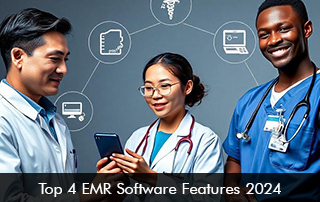Healthcare operations and patient care were revolutionized with the advent of Electronic Medical Records (EMR) Software. The robust EHR Software systems changed how information was handled and transferred between different platforms leading to better care coordination. Earlier, providers were inhibited from using electronic health records software; some even felt it added to clinician burnout. However, EMR Systems vendors were quick to add innovative solutions of Artificial Intelligence and NLP to automate note-taking and documentation. This gave more time for providers to focus on patient care and enhance overall healthcare delivery.
The Benefits of Utilizing EHR Software
The following advantages can be reaped when Electronic Health Records (EHR) are implemented in hospitals and healthcare organizations:
- Real-time patient data access
- Improved patient care
- Automated daily processes
- Streamlined workflows
- Enhanced productivity levels
- Reduced errors
- Lower operational costs
- Improved compliance and reporting
- Better security with HIPAA-Compliant EMR Software
- Stimulates patient engagement
- Growth adaptability
Top 4 EMR Software Functionalities in 2024
In 2024, healthcare providers should especially look for the following Electronic Medical Records (EMR) Software tools to take productivity and patient care to the next level. A top-ranked EHR Software will provide complete, intuitive, and robust functionality to empower clinicians and keep their stress levels at bay.
Number 1 HIPAA compliance
With cybersecurity threats on the rise and ransomware attacks increasing by 264% in the past 5 years, it becomes critical for healthcare organizations to deploy an EMR Software System that is HIPAA compliant. HIPAA compliance will ensure that patient data is protected and secure to combat any threats. Features of HIPAA compliance in electronic health records software include data encryption techniques, user authentication, and access controls.
Number 2 Cloud-Based Functionality
The affordability, adaptability, and scalability of cloud-based EMR software have contributed to its meteoric rise in popularity in recent years. These systems are becoming more and more popular among healthcare practitioners in 2024 since they are more affordable and can be used by practices of any size with their subscription-based business model. Cloud-based EHR systems facilitate telemedicine and remote work by providing convenient access to patient records from any place. Cloud technology can also take care of maintenance and updates automatically, making sure that the software is always current without interfering with daily operations. Cloud-based EMR software has become the go-to option for contemporary healthcare practices due to its improved data security, compatibility with other healthcare systems, and compliance with government requirements like HIPAA.
Number 3 Robust Charting Tools
Charting features in Electronic Health Records Software can automate the tedious process of recording patient information. Charting tools can help minimize errors and improve documentation accuracy. Providers can quickly document diagnosis and treatment plans. The integration of AI tools in charting has furthermore made documentation and note-taking more efficient. Providers can dictate notes, and have more meaningful patient encounters.
Number 4 Patient Engagement
Patients of today want to feel on top of their healthcare journey. Through patient engagement solutions like the patient portal EMR Software platform, patients can actively participate. Via the portal, patients can easily schedule appointments, pay online bills, communicate with their providers, update their health information, and even view lab results. Patient engagement solutions can bridge any communication gaps and strengthen patient and provider relations. This can have a positive impact on health outcomes ultimately.








